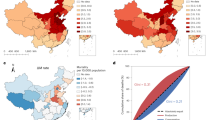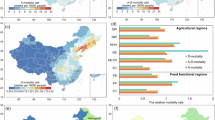Abstract
Agricultural intensification produces indirect emissions beyond ammonia volatilization from activities such as machinery usage, food processing, transportation, storage and energy inputs. Here we integrate an input–output analysis with air quality modelling approaches, showing that attributable mortality from indirect emissions has risen sixfold in China over the past 37 years. Indirect emissions now account for one-quarter of air pollution-related attributable mortality associated with food consumption. We find a marked redistribution of the indirect health burden, with low-income groups experiencing an additional 58% attributable deaths compared with their expected food consumption burdens, which were initially associated with the food consumption of high-income groups. Targeted strategies using abatement approaches could halve the indirect health burden, thereby mitigating the environmental impact of food consumption amid agricultural intensification.
This is a preview of subscription content, access via your institution
Access options
Access Nature and 54 other Nature Portfolio journals
Get Nature+, our best-value online-access subscription
$32.99 / 30 days
cancel any time
Subscribe to this journal
Receive 12 digital issues and online access to articles
$119.00 per year
only $9.92 per issue
Buy this article
- Purchase on SpringerLink
- Instant access to full article PDF
Prices may be subject to local taxes which are calculated during checkout






Similar content being viewed by others
Data availability
The data that support the findings of this study are available within the paper and the Supplementary Information. Population and per capita income data from the National Bureau of Statistics of China are available at http://data.stats.gov.cn/. Multi-year Input–output tables for China are provided by the Chinese Input–Output Association and are available at http://cioa.ruc.edu.cn/zlxz/trccb/7d9453899536434a9004d2db40e4bf6b.htm. Source data are provided with this paper. These data are also available via Zenodo at https://doi.org/10.5281/zenodo.11070822 (ref. 50).
Code availability
Python 3.8 was used in conducting the Environmental Extended Input–Output Analysis and subsequent data analysis. The source codes used in this research are available via Zenodo at https://doi.org/10.5281/zenodo.11070822 (ref. 50).
References
Godfray, H. C. J. et al. Meat consumption, health, and the environment. Science 361, eaam5324 (2018).
Tilman, D., Balzer, C., Hill, J. & Befort, B. L. Global food demand and the sustainable intensification of agriculture. Proc. Natl Acad. Sci. USA 108, 20260–20264 (2011).
Robinson, T. P. et al. Global Livestock Production Systems (FAO and ILRI, 2011).
Crippa, M. et al. Food systems are responsible for a third of global anthropogenic GHG emissions. Nat. Food 2, 198–209 (2021).
Clark, M. & Tilman, D. Comparative analysis of environmental impacts of agricultural production systems, agricultural input efficiency, and food choice. Environ. Res. Lett. 12, 064016 (2017).
Springmann, M. et al. Options for keeping the food system within environmental limits. Nature 562, 519–525 (2018).
Clark, M. et al. Estimating the environmental impacts of 57,000 food products. Proc. Natl Acad. Sci. USA 119, e2120584119 (2022).
Ivanovich, C. C., Sun, T., Gordon, D. R. & Ocko, I. B. Future warming from global food consumption. Nat. Clim. Chang. 13, 297–302 (2023).
Xu, P. et al. Fertilizer management for global ammonia emission reduction. Nature 626, 792–798 (2024).
Domingo, N. G. et al. Air quality–related health damages of food. Proc. Natl Acad. Sci. USA 118, e2013637118 (2021).
Crippa, M., Solazzo, E., Guizzardi, D., Van Dingenen, R. & Leip, A. Air pollutant emissions from global food systems are responsible for environmental impacts, crop losses and mortality. Nat. Food 3, 942–956 (2022).
Ma, R. et al. Mitigation potential of global ammonia emissions and related health impacts in the trade network. Nat. Commun. 12, 6308 (2021).
D’odorico, P., Carr, J. A., Laio, F., Ridolfi, L. & Vandoni, S. Feeding humanity through global food trade. Earths Future 2, 458–469 (2014).
Yu, Q., Wu, W. & Tang, H. Increased food-miles and transport emissions. Nat. Food 4, 207–208 (2023).
Li, M. et al. Global food-miles account for nearly 20% of total food-systems emissions. Nat. Food 3, 445–453 (2022).
Adalibieke, W. et al. Decoupling between ammonia emission and crop production in China due to policy interventions. Glob. Chang. Biol. 27, 5877–5888 (2021).
Li, B. et al. Improved gridded ammonia emission inventory in China. Atmos. Chem. Phys. 21, 15883–15900 (2021).
Bai, Z. et al. Food and feed trade has greatly impacted global land and nitrogen use efficiencies over 1961–2017. Nat. Food 2, 780–791 (2021).
Gil, J. D. B. et al. Sustainable development goal 2: improved targets and indicators for agriculture and food security. Ambio 48, 685–698 (2019).
NBS China Statistical Yearbook 2017 (China Statistics Press, 2018).
Lang, J. et al. A high temporal-spatial resolution air pollutant emission inventory for agricultural machinery in China. J. Clean. Prod. 183, 1110–1121 (2018).
Zhao, H. et al. Air pollution health burden embodied in China’s supply chains. Environ. Sci. Ecotechnol. 16, 100264 (2023).
Zhao, S. et al. A multiphase CMAQ version 5.0 adjoint. Geosci. Model Dev. 13, 2925–2944 (2020).
Burnett, R. et al. Global estimates of mortality associated with long-term exposure to outdoor fine particulate matter. Proc. Natl Acad. Sci. USA 115, 9592–9597 (2018).
Geng, G. et al. Efficacy of China’s clean air actions to tackle PM2.5 pollution between 2013 and 2020. Nat. Geosci. 17, 987–994 (2024).
Huang, X. et al. A high‐resolution ammonia emission inventory in China. Glob. Biogeochem. Cycles 26, GB1030 (2012).
Zheng, L. et al. Health burden from food systems is highly unequal across income groups. Nat. Food 5, 251–261 (2024).
Zhong, T., Si, Z., Crush, J., Scott, S. & Huang, X. Achieving urban food security through a hybrid public-private food provisioning system: the case of Nanjing, China. Food Secur. 11, 1071–1086 (2019).
He, P., Baiocchi, G., Hubacek, K., Feng, K. & Yu, Y. The environmental impacts of rapidly changing diets and their nutritional quality in China. Nat. Sustain. 1, 122–127 (2018).
Zhai, F. et al. Dynamics of the Chinese diet and the role of urbanicity, 1991–2011. Obes. Rev. 15, 16–26 (2014).
Lam, H.-M., Remais, J., Fung, M.-C., Xu, L. & Sun, S. S.-M. Food supply and food safety issues in China. Lancet 381, 2044–2053 (2013).
Xia, L., Ti, C., Li, B., Xia, Y. & Yan, X. Greenhouse gas emissions and reactive nitrogen releases during the life-cycles of staple food production in China and their mitigation potential. Sci. Total Environ. 556, 116–125 (2016).
Du, Y. et al. A global strategy to mitigate the environmental impact of China’s ruminant consumption boom. Nat. Commun. 9, 4133 (2018).
Wang, X., Bodirsky, B. L., Müller, C., Chen, K. Z. & Yuan, C. The triple benefits of slimming and greening the Chinese food system. Nat. Food 3, 686–693 (2022).
Bai, Z. et al. China’s livestock transition: driving forces, impacts, and consequences. Sci. Adv. 4, eaar8534 (2018).
Gu, B. et al. Toward a generic analytical framework for sustainable nitrogen management: application for China. Environ. Sci. Technol. 53, 1109–1118 (2019).
Zhang, Q. et al. Drivers of improved PM2.5 air quality in China from 2013 to 2017. Proc. Natl Acad. Sci. USA 116, 24463–24469 (2019).
Huang, Y. et al. Quantification of global primary emissions of PM2.5, PM10, and TSP from combustion and industrial process sources. Environ. Sci. Technol. 48, 13834–13843 (2014).
Huang, T. et al. Spatial and temporal trends in global emissions of nitrogen oxides from 1960 to 2014. Environ. Sci. Technol. 51, 7992–8000 (2017).
Huang, Y. et al. Global organic carbon emissions from primary sources from 1960 to 2009. Atmos. Environ. 122, 505–512 (2015).
Xu, H. et al. Updated global black carbon emissions from 1960 to 2017: improvements, trends, and drivers. Environ. Sci. Technol. 55, 7869–7879 (2021).
Wang, C. et al. A high-resolution ammonia emission inventory for cropland and livestock production in China. Chin. J. EcoAgric. 29, 1973–1980 (2021).
Zhang, H., Xia, M., Su, R. & Lin, C. The compilation of the time series input–output tables in China: 1981–2018. J. Stat. Res. 38, 3–23 (2021).
Burnett, R. & Cohen, A. Relative risk functions for estimating excess mortality attributable to outdoor PM2.5 air pollution: evolution and state-of-the-art. Atmosphere 11, 589 (2020).
Hammitt, J. K., Morfeld, P., Tuomisto, J. T. & Erren, T. C. Premature deaths, statistical lives, and years of life lost: identification, quantification, and valuation of mortality risks. Risk Anal. 40, 674–695 (2020).
Murray, C. J., Ezzati, M., Lopez, A. D., Rodgers, A. & Vander Hoorn, S. Comparative quantification of health risks: conceptual framework and methodological issues. Popul. Health Metr. 1, 1–20 (2003).
Hakami, A. et al. The adjoint of CMAQ. Environ. Sci. Technol. 41, 7807–7817 (2007).
Rose, A., McKee, J., Urban, M. & Bright, E. LandScan Global (Oak Ridge National Laboratory, 2018).
Naghavi, M. et al. Global burden of 288 causes of death and life expectancy decomposition in 204 countries and territories and 811 subnational locations, 1990–2021: a systematic analysis for the Global Burden of Disease Study 2021. Lancet 403, 2100–2132 (2024).
Zheng, L. Indirect emissions contribute a quarter of air pollution-related health burden of food systems in China. Zenodo. https://doi.org/10.5281/zenodo.11070822 (2024).
Acknowledgements
H.S. acknowledges funding from the Ministry of Science and Technology of the People’s Republic of China (2023YFE0112901) and the National Natural Science Foundation of China (42192512 and 42475108). F.Z. acknowledges funding from the National Natural Science Foundation of China (42225102). L. Zheng acknowledges funding from the National Natural Science Foundation of China (424B2039). H.S. acknowledges funding from the Shenzhen Science and Technology Program (KQTD20240729102048052, JCYJ20241202152804007 and JCYJ20220818100611024). X.Y., T.-M.F. and H.S. acknowledge funding from the Shenzhen Key Laboratory of Precision Measurement and Early Warning Technology for Urban Environmental Health Risks (ZDSYS20220606100604008). C.W. acknowledges technical support from Southern University of Science and Technology Core Research Facilities. H.S. acknowledges support from the Center for Computational Science and Engineering at Southern University of Science and Technology, as well as funding from the High-level University Special Fund (G03050K001).
Author information
Authors and Affiliations
Contributions
H.S., J.M., P.H. and F.Z. conceived and initiated the study. L. Zheng and W.A. developed and analysed the emission inventory and the related health burden datasets. Y.C., P.G., J.H., Y.Z., J.L., W.L. and Y.G. collected and processed the supporting data for the mitigation schemes. P.X., C.W., J.Y. and L. Zhu assisted in developing the integrated model framework. L. Zheng drafted the paper, with critical input from G.S., T.-M.F. and X.Y., who participated in the result discussions. H.S., F.Z., J.M., P.H., S.Z. and A.H. contributed valuable critical revisions.
Corresponding authors
Ethics declarations
Competing interests
The authors declare no competing interests.
Peer review
Peer review information
Nature Food thanks Stefan Reis, Rong Tang and the other, anonymous, reviewer(s) for their contribution to the peer review of this work.
Additional information
Publisher’s note Springer Nature remains neutral with regard to jurisdictional claims in published maps and institutional affiliations.
Supplementary information
Supplementary Information
Supplementary Figs. 1–11, Tables 1–7 and Text 1 and 2.
Supplementary Data 1
Source data for Supplementary Figs. 1–9.
Source data
Source Data Fig. 2
Statistical source data for Fig. 2.
Source Data Fig. 3
Statistical source data for Fig. 3.
Source Data Fig. 4
Statistical source data for Fig. 4.
Source Data Fig. 5
Statistical source data for Fig. 5.
Source Data Fig. 6
Statistical source data for Fig. 6.
Rights and permissions
Springer Nature or its licensor (e.g. a society or other partner) holds exclusive rights to this article under a publishing agreement with the author(s) or other rightsholder(s); author self-archiving of the accepted manuscript version of this article is solely governed by the terms of such publishing agreement and applicable law.
About this article
Cite this article
Zheng, L., Adalibieke, W., Zhou, F. et al. Indirect emissions contribute a quarter of air pollution-related health burden of food systems in China. Nat Food 6, 766–776 (2025). https://doi.org/10.1038/s43016-025-01193-0
Received:
Accepted:
Published:
Issue date:
DOI: https://doi.org/10.1038/s43016-025-01193-0



